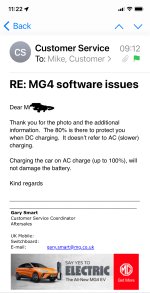Speaking of other countries... I have my software "updated" yesterday, on my request to get some issue sorted, and to get OPD enabled. Also I asked the team to check my under tray, and I noticed the drive shaft end, and nut is kind of rusty, so I wanted some advice.
On pickup, they told me they updated a bunch of things (BMS, CCU, EVCC, FDR, FVCM, GW, IMCU, IPK), also they ordered a replacement under tray (I'm the first one here in NZ who has this issue), also the rust is normal...
As far I can tell, nothing changed (MPU, MCU sw version) or even under the "engineering info" everything appears to be the same. However, the ACC speed adjustment has been changed (long press vs short press), so that is more sensible now. I'm not sure whether the AEB or LKA improved, but certainly the ACC keeps the speed on small curves, which was not quite like this before, but still brakes every now and then, without obvious reason.
The best thing what I've got from this, I've got an MG ZS loaner. The software is pretty much same "under developed" as on my MG4, plus the driving comfort and responsiveness is way wore. I mean very bad, delay on acceleration, braking, spongy brake pedal and wobbly suspension. It was also 2023 car, travelled about 1000 km more than my MG4. So I getting more satisfied with my ride, and less critical about what annoys me. I would trade the ACC though, that was seamless on the ZS.
Anyone can tell me how/where else can I found information about the SW update in the MG4?

